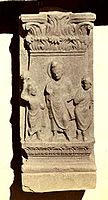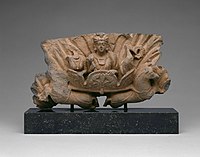Indo-Corinthian capital



Right image: An Indo-Corinthian capital with a palmette and the Buddha at its centre, 3-4th century, Gandhara.
Indo-Corinthian capitals are capitals crowning columns or pilasters, which can be found in the northwestern Indian subcontinent, and usually combine Hellenistic and Indian elements. These capitals are typically dated to the first centuries of the Common Era, and constitute an important aspect of Greco-Buddhist art.
Corinthian design
Indo-Corinthian capitals display a design and foliage structure which is derived from the academic Corinthian capital developed in Greece. Its importation to India followed the road of Hellenistic expansion in the East in the centuries after the conquests of Alexander the Great. In particular the Greco-Bactrian kingdom, centered on Bactria (today's northern Afghanistan), upheld the type at the doorstep of India, in such places as Ai-Khanoum until the end of the 2nd century BCE. In India, the design was often adapted, usually taking a more elongated form and sometimes being combined with scrolls, generally within the context of Buddhist stupas and temples.
Figurines

Indo-Corinthian capitals also incorporated figures of the Buddha or Bodhisattvas, usually as central figures surrounded by, and often under the shade of, the luxurious foliage of Corinthian designs. This practice was not limited to India, and also found favor in various areas of Central Asia. The depiction of figurines within the foliage of Corinthian capitals is not in itself an eastern development. In the ancient Greek world in the Mediterranean, figurines were often represented this way:
Figural additions are very common in the classical world, and from an early period, usually take the form of heads or busts, but the Gandhara treatment is original in that the acanthus leaves form a canopy over it.[2]
Combinations with Buddhist architecture
Indo-Corinthian capital were also used in combination with architectural elements, such as Buddhist stupas. One of the best example was excavated and reconstituted at Sirkap.
Perhaps the most notable divergence from the western concept of function occurs at Kalawan, Taxila, where a large acanthus capital set on a lotus base was inserted between the conventional square basement and cylindrical dome of a votive stupa.[2]
Further, in the art of Gandhara, Indo-Corinthian capitals on top of separating pilasters are used extensively in narrative friezes of the life of the Buddha. This usage continued as late as the 5th century.
Gallery
-
 Base of pillar, Indo-Corinthian capitals and elephants from base of stupa, Jamal Garhi
Base of pillar, Indo-Corinthian capitals and elephants from base of stupa, Jamal Garhi -
 An Indo-Corinthian capital from the Butkara Stupa under which a coin of Azes II was found. Dated to 20 BCE or earlier (Turin City Museum of Ancient Art).
An Indo-Corinthian capital from the Butkara Stupa under which a coin of Azes II was found. Dated to 20 BCE or earlier (Turin City Museum of Ancient Art). -
 Indo-Corinthian capital representing a Buddhist devotee wearing a Graeco-Roman coat with fibula. Butkara Stupa, National Museum of Oriental Art, Rome.
Indo-Corinthian capital representing a Buddhist devotee wearing a Graeco-Roman coat with fibula. Butkara Stupa, National Museum of Oriental Art, Rome. -
 A pilaster decorated by a Corinthian capital and a female figurine, Athens, 2nd-1st century BCE.
A pilaster decorated by a Corinthian capital and a female figurine, Athens, 2nd-1st century BCE. -
 The Buddha, within the foliage of a Corinthian capital.
The Buddha, within the foliage of a Corinthian capital. -
 Series of Indo-Corinthian capitals from Jamal-Garhi.
Series of Indo-Corinthian capitals from Jamal-Garhi. - A Buddhist triad flanked by two pilasters with Indo-Corinthian capitals, Gandhara, 3rd century CE.
-
 Indo-Corinthian canopy at the Chakhil-i-Ghoundi stupa, Hadda.
Indo-Corinthian canopy at the Chakhil-i-Ghoundi stupa, Hadda. -
 Small Gandhara architectural pillar
Small Gandhara architectural pillar -
 Capital with central quadriga. Butkara Stupa.
Capital with central quadriga. Butkara Stupa. -
 Indo-Corinthian capital featuring the charriot-driving sun god Surya. Gandhara, 2nd century CE.
Indo-Corinthian capital featuring the charriot-driving sun god Surya. Gandhara, 2nd century CE.
See also

References
- ^ Errington, Elizabeth (2017). Charles Masson and the Buddhist Sites of Afghanistan: Explorations, Excavations, Collections 1832–1835. British Museum. pp. 156–159.
- ^ a b Errington, Elizabeth; Cribb, Joe; Claringbull, Maggie (1992). The Crossroads of Asia: Transformation in Image and Symbol in Art of Ancient Afghanistan and Pakistan. Cambridge: Ancient India and Iran Trust. p. 205. ISBN 0-9518399-1-8.























